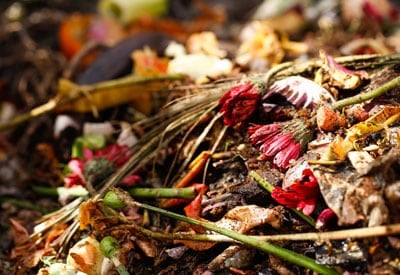“The earth neither grows old or wears out if it is dunged.” – Columella, circa 45 A.D
This time of year, as we’re reaping the rewards of fresh vegetables provided from our fall composting efforts (among other things), we’re also looking forward to the next harvest. No, not the future harvests from our garden patch (though that will happen soon enough), but the yields from our heaps and tumbler. We believe that composting is the central tenet of organic gardening and this is the time of year that the results prove it. It’s also the time of year, with our supply of finished compost mostly exhausted, that we commit ourselves to continuing the practice.
By September, we’re pretty much finished scooping the last good compost out of our number two heap and screening it before applying under our vegetables, around our shrubs and trees and across our lawns (those of you who use the three-heap method still know what we mean). Over in our starter heap are the grass clippings we’ve collected all summer, and any disease-free vegetable trimming from earlier in the season. We’ve also added a few twigs from that early summer wind storm. We may have to screen them out during final composting but until then they’ll help created air pockets that will supply oxygen to the process.

FREE SHIPPING!
EZ-Tumbler (90 gal.)
This workhorse is made entirely in the USA of 100% recycled materials.
$269.95Learn moreConvert yard and garden waste into soil-nourishing organic matter with our backyard tested composting bins and supplies. Need advice? Visit our Compost Blog for the basics and some insider tips from the pros.
We’ve emptied the finished compost made of kitchen scraps and various other browns and greens that we started in June from our tumbler (after emptying the compost started in March). We’ve finally got this compost tumbling thing down to an art, turning out usable compost that isn’t too slimy or not completely decomposed in about three months or so. Its took some practice, sure, but getting the right balance of green materials, brown materials and water, teamed with frequent tumbling, give relatively quick and soil-ready results. We’ll probably get another mostly finished tumbler full of material by Thanksgiving depending on how many warm days we have between now and then. By December, things in the tumbler will slow considerably but we’ll still add kitchen scraps if the lid hasn’t frozen shut.
Now we have five or six weeks to get ready for the bounty Mother Nature will provide. When we start adding leaves to our heaps they’ll grow by leaps and bound. One problem: finding enough greens to balance them. These high-in-nitrogen additions become harder to source as the fall progresses. Everything pulled from your garden counts, though again, make sure it’s not diseased. I’ve had the advantage of adding manure from an organic goat dairy; it doesn’t take much to reach a good carbon-nitrogen balance. If you’ll have leaves in abundant quantities, you might want to plan on making leaf mold. Using leaves as mulch around shrubbery or young trees to protect roots from freezing is also a good idea. But there’s plenty of time to consider that.
So now’s the time to plan and build. Maybe you want to build a three-heap bin (or in my case, add a third bin to the two I already have). Maybe you want to consider buying a tumbler, especially if you live in a warmer climate where winter-long frozen conditions and consecutive hard frosts aren’t a problem (in other words, a place where your pile will heat up year ’round). Maybe you want to start kitchen composting indoors during the winter or start a worm bin in a corner of your basement or garage. Anyway you go, now’s the time to start planning. You’ll be glad next summer, and the summers beyond, that you did.











